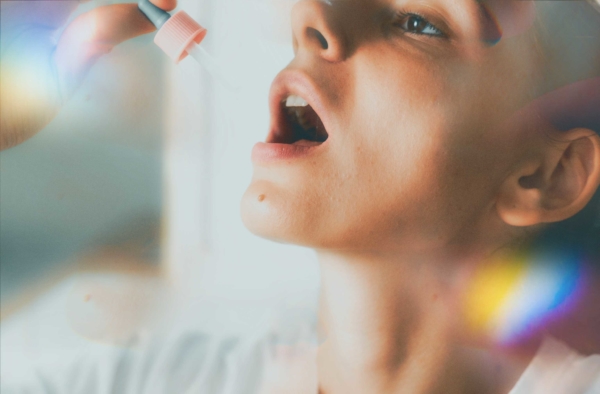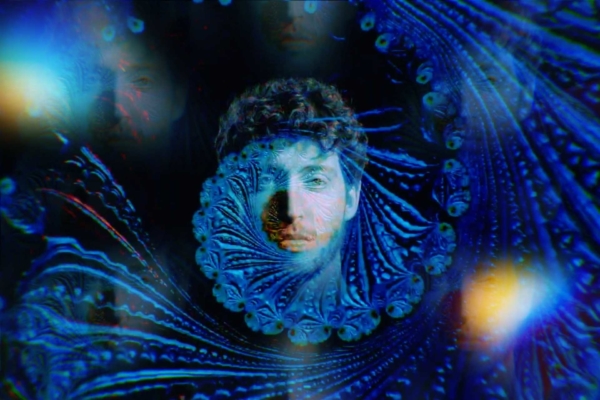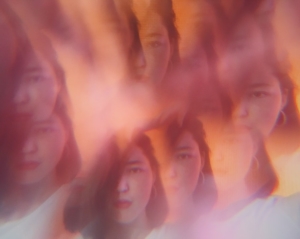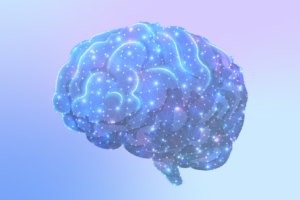
Due to the fact that different methods of achieving altered states of consciousness, such as psychedelics, meditation, and hypnosis often lead to highly subjective experiences, many individuals assume that the neurological effects of these practices are similar. However, a group of researchers conducted a study that demonstrated that the actual brain changes induced by these methods are unique and distinct.
The findings in the recent study published in Biological Psychiatry: Cognitive Neuroscience and Neuroimaging showcase that while subjective experiences may be similar, the brain changes and neuroplasticity produced by psilocybin, LSD, meditation, and hypnosis are different.
While there have been numerous debates on which method is superior, this study is the first to compare the neural correlates of these two methods. To bridge this knowledge gap, scientists at the University of Zurich’s Psychiatric Hospital directly compared two pharmacological methods: dosing patients with psilocybin and LSD, and two non-pharmacological methods: hypnosis and meditation. They used resting state functional connectivity magnetic resonance imaging (rs-fcMRI) to assess the predictive value of the data, employing a machine learning approach.
“We combined four different datasets that were collected at the Psychiatric University Hospital in Zurich using the same MRI-scanner,” Nathalie Rieser, one of the study’s lead researchers explained. “For the psychedelic studies, we included healthy participants who subsequently received psilocybin, LSD, or a placebo, whereas the meditation and hypnosis studies were conducted with participants who were experts in the respective field to make sure they can reach the state in an MR environment.”
What they found is that:
-
Psychedelics, meditation and hypnosis induce different altered states of consciousness.
-
The unique patterns of connectivity induced by the different methods can help us predict individual responses to the treatments.
- Psilocybin and LSD show similar effects in functional connectivity when directly compared to each other. However, both psychedelics show “distinct behavioral-neural relationships.”
Study Results
Participants were simply asked to lay inside an MRI scanner without any specific task or activity. The scanner recorded their brain activity while in a normal state of consciousness, then again under the altered state of consciousness relevant to each trial. The team analyzed the whole brain activity and found that while the subjective effects of psilocybin, LSD, meditation and hypnosis may overlap, the underlying brain changes are distinct.
“Our findings show that even though psilocybin, LSD, meditation, and hypnosis induce overlapping subjective effects, the underlying brain changes are distinct,” Reiser says.
1. Psychedelics, meditation and hypnosis induce different altered states of consciousness
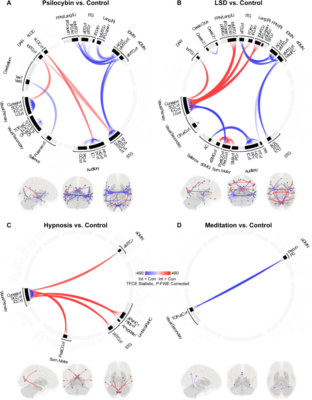
While observing the subjects under psilocybin, LSD, meditation and hypnosis, the researchers found that “no network reaches significance in all four [altered states of consciousness] methods”, which suggests that different methods may induce different types of ASC.
Psilocybin and LSD: Both psilocybin and LSD increased connectivity between sensory and associative networks while decreasing connections between different associative networks and within sensory networks.
Hypnosis: Hypnosis, on the other hand, decreased connectivity within the human primary visual cortex (V1 network), involved in processing visual information, but increased connectivity between the V1 network and other networks involved in the default mode network (DMN) and limbic regions.
Meditation: Meditation decreased connectivity between the posterior DMN and secondary visual networks.
Moreover, hypnosis and meditation show distinct differences when directly compared to psilocybin and LSD.
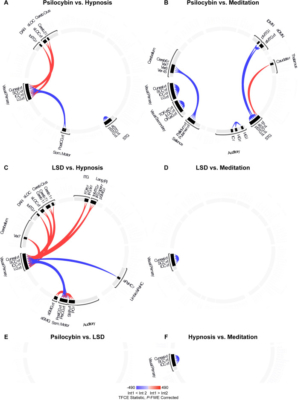
Psilocybin and LSD vs. Hypnosis: When comparing psilocybin and LSD to hypnosis, the researchers found that both drugs “increased connectivity between regions involved in sensory and associative networks”, which essentially means that the communication between the regions involved in how we sense things and process information was increased. They also observed “decreased connectivity between regions involved in sensory networks”.
Psilocybin and LSD vs. Meditation: When comparing psilocybin and LSD to meditation, there was a common change in connectivity, specifically a reduced communication within V1. Based on this, the researchers suggest that hypnosis may be more effective than meditation in inducing decreased connectivity within V1.
Meditation vs. Hypnosis: Directly comparing both methods showed that hypnosis decreased communication within the V1 network compared to meditation.
2. The unique patterns of connectivity induced by the different methods can help us predict individual responses to the treatments
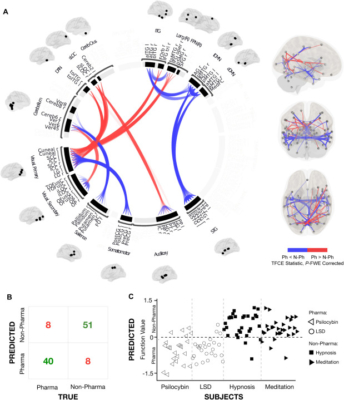
Pharmacological and non-pharmacological methods have distinct patterns: The researchers noted that inducing altered states through psilocybin and LSD, compared to meditation and hypnosis, showed “distinct connectivity patterns that are predictive at the individual level.” In terms of brain connectivity, the researchers observed that altered states of consciousness produced by psychedelics have a significantly different effect on resting-state networks, compared to meditation and hypnosis. Psilocybin and LSD decreased the communication between and within various associative networks, such as the default mode network (DMN) and superior temporal gyrus (STG), while increasing connectivity between the primary visual cortex and networks such as the inferior temporal gyrus and dorsal attention network.
The distinct patterns can help predict individual responses to treatments: When testing this hypothesis, by using a computer-based method called a “binary SVM,” the researchers found that they could predict whether a subject had experienced altered states of consciousness induced by psychedelics or through meditation and hypnosis with an accuracy of 85.05%. By analyzing how the predictions were made, the researchers saw that the connections in the V1 and somatomotor networks played a significant role in making an accurate prediction of which method was used to achieve ASC.
Final Thoughts
Although some may report similar experiences or feelings while on classical psychedelics, while meditating, or during hypnosis, the researchers found that brain activity that takes place during those states is vastly different. It turns out that psychedelic substances and meditation might seem similar, but the underlying mechanisms of action and overall effects on the brain are very different. These findings offer valuable insights into the complex interplay between our brains and the states of consciousness we experience.
